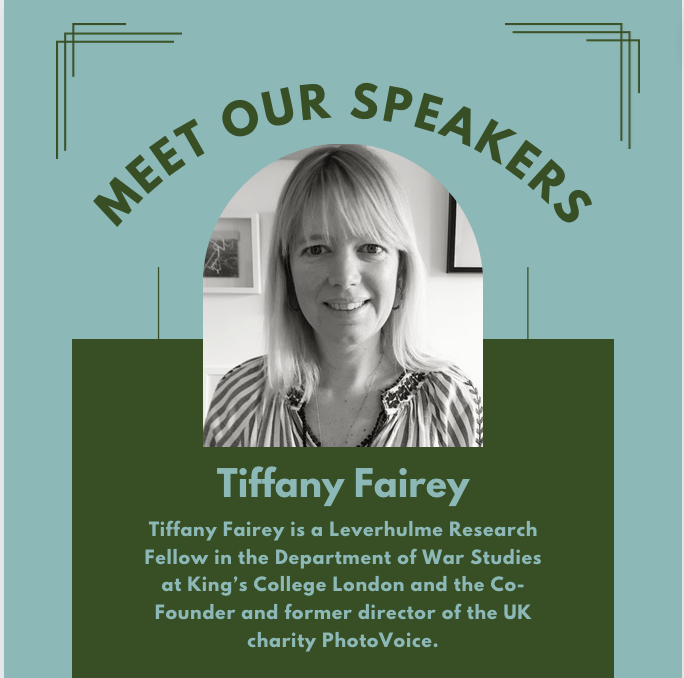For the conference, “30 years of Photovoice: Past, present and future,” we asked our speakers to share with us some of their expertise and experiences. This blog post focuses on the conference speaker, Tiffany Fairey. To learn more about the conference, visit our website: www.photovoiceconference.com.

Tiffany Fairey
Tiffany Fairey is a Leverhulme Research Fellow in the Department of War Studies at King’s College London. Co-Founder and former director of the UK charity PhotoVoice, she has 20+ years’ specialist experience working with photovoice and participatory visual methods in the UK and internationally. She completed her PhD in Visual Sociology (Goldsmiths College) with research into community photography histories and participatory photography ethics and impact. Her current research, Imaging Peace, focuses on the role of images and community engaged image-making in building peace and dialogue. Collaborating with partners in Colombia, Nepal, Rwanda, Northern Ireland and BiH, Fairey is conducting the first multi-country empirical study of community engaged peace photography. Her work has been recognized with various awards including the Royal Photographic Society’s Hood Medal for outstanding advance in photography for public service (2010) and King’s College SSPP Impact Award (2022).
What drove you to use photovoice or participatory photography and what motivated you to stay?
I first worked with participatory photography in 1998, nearly 25 years ago. I was a social anthropology undergraduate student and I spent 7 months working with a group of young people from Bhutan who were growing up as refugees living in camps in Nepal. That project ended up running for over 10 years. I have been working with participatory photography and photovoice ever since on over 50 different projects all over the world. I co-founded, built and ran the UK based organization PhotoVoice for its first 10 years. I then did my PhD (Visual Sociology) on the ethics and impact of participatory photography projects. I am now work as both a practitioner and researcher specializing in photovoice and participatory visual methods. I am based at King’s College London, in the Department of War Studies, where I am undertaking a Leverhulme Research Fellowship focusing on the role of images and image-making in building peace and dialogue. I undertaking action research and building case studies of community engaged peace photography initiatives in countries dealing with recent histories of violence and conflict.
Photography had been my big passion since I was 14. I had thought I wanted to be a documentary photographer but when I went to study photography after I finished school I felt uncomfortable with what it meant to represent others, the power dynamics involved in defining how others are seen. Especially as a young women with limited life experience – what did I know about how to represent others? At times, taking photographs of other people felt like putting words into their mouths and this did not feel right to me. I carried on with my own photography and went off to study social anthropology at university. A year or so later I came across a tiny article in a magazine about an exhibition of photography by Guatemalan youth in London. The project was called Out of the Dump (now called FotoKids) and it is still going to this day, run by the photographer Nancy McGirr. I knew immediately that was what I wanted to do – to work with others using photography to understand how they saw the world. I have been working with participatory photography and photovoice ever since, nearly 25 years!
What is one piece of advice you would give to someone new to photovoice?
Listen carefully to your participants and partners to ensure you collaboratively design a photovoice project that is relevant and meaningful to all involved. Make sure you give enough time and space for the photovoice process to evolve at the pace it needs to.
What has been a favorite photovoice or participatory photography project of yours? Would you be able to share any project photos with us?
There have been so many favorites – it is hard to choose!
The work I did over 8 years in London with young people who came to the UK as unaccompanied refugee children holds a special place in my heart as we were all learning together about the power, dynamics and tensions around participatory photography.
And also from one of the most recent projects I have been working on with Everyday Peace Indicators in Colombia where participants from communities directly affected by the 50 year conflict have photographed their indicators of peace, coexistence and justice. Their photographs were hung all over their villages on walls and buildings creating a giant open air peace photography museum.
What lessons have you learned throughout your career?
People come to using photovoice with a diverse range of expectations and ideas about what it may or may not involve. I do not work with standardized models of participatory photography or photovoice. In many senses photovoice is re-invented each time it is used as it is adapted to different research contexts and objectives so I find I learn new and different lessons on every project. A key lesson is that for photovoice to work participants have to want to be involved, it needs to be enjoyable. Participatory photography projects are about building connections and dialogue and this won’t happen if people don’t feel safe, comfortable or respected. Good facilitation is everything! Another key lesson is the importance of pre-empting or pre-thinking about ethical or protection issues that might arise as part of the project process. In many projects I am working with communities or participants that are living in difficult circumstances or with difficult experiences, they may be categorized as ‘marginalized’ or ‘vulnerable’ – thinking through and being ready for issues that might come up is so important. Being conscious of the potential harms that photovoice projects can do is key. Images brings with them their own specific set of ethical issues and often people who have not worked with photography before do not think of these or make provisions for them in advance. Participants need to be able to make informed decisions about their participation and this process of informed consent needs to be carefully and intentionally woven through the project. It is important to think about the project end from the beginning and to build networks around projects. Finally, the lesson I never seem to learn – there is never enough time!
What are the most critical changes we need to make to photovoice and participatory photography to face the future effectively?
There is a need for much more information and resources for practitioners and researchers that are starting to work with participatory visual methods to ensure they are using them critically, reflexively and ethically. Much of the literature is celebratory but there is nothing inherently empowering about photovoice. Images are not neutral. Transparency about the process is vital: about how the methods are being used and applied, about what constitutes participation, about how power operates, about how the images are being shared and analyzed.
What are people’s common misconceptions about photovoice and participatory photography, and how can we combat them?
Often practitioners and researchers come to photovoice because they like the idea of the images – the focus is on the images and testimonies as research data rather than on the quality of the image-making, participatory and dialogical processes for participants. Like all participatory methods, photovoice can be done in tokenistic and extractive ways and we need to combat this. The aim is not to insist on formulaic approaches to photovoice because the flexibility and adaptability of the method is one of its great strengths but to create more debate and dialogue around best and ethical principles in photovoice and pp practice.
Is there a specific way you’d like to see photovoice implemented that hasn’t been done before?
I would be interested in seeing more photovoice projects that effectively use social media.
How has COVID influenced the way you use Photovoice? Are there any new strategies you intend to keep?
I have been working more remotely and at distance, in collaboration, supporting and mentoring other practitioners and researchers who are delivering photovoice projects themselves in person and remotely. I definitely will continue to work this way.
